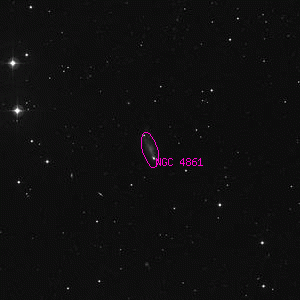NGC 4861

Overlaid DSS image of NGC 4861, 30' x 30' with north at top and west to the right
Aladin viewer for the region around NGC 4861
H IV 30, h 1499, GC 3340, IC 3961, MCG+06-29-003, VV 797a, Arp 266, UGC 8098, PGC 44536, SDSS J125901.91+345121.4
| Type | Galaxy |
|---|---|
| Magnitude | 12.32 |
| Size | 3.63' x 1.48' @ 15° |
| Right Ascension | 12h 59' 2.4" (2000) |
| Declination | 34° 51' 34" N |
| Constellation | Canes Venatici |
| Description | vF, pL, vmE30, bet 2 st |
| Classification | Im/BCD |
Observing Notes
Harold Corwin
IC 3961 = NGC 4861, which see. The entire galaxy is clearly marked on the original 16-inch Bruce plate (one of the "stars" mentioned in Wolf's description is the bright HII region), and Herschel's description also clearly applies to the entire galaxy. The identity is certain, and the CGCG's contention that NGC 4861 is only the bright HII region in IC 3961 is wrong.
By the way, Dreyer has the incorrect number from Wolf's list copied into the IC. IC 3961 is number 103 in Wolf's fifth list, not number 105 (which is correctly applied to IC 3966). My thanks to Courtney Seligman for pointing this out.
Harold Corwin
NGC 4861 = IC 3961. Both of these numbers certainly apply to the galaxy itself and not, as supposed by CGCG, the first to the bright HII region, an d the second to the galaxy. William Herschel's and Lord Rosse's (on three nights) descriptions leave no doubt that they saw the galaxy clearly. Not only are Wolf's position and description very accurate, he has also marked the correct object on his plate (though one of the "stars" which he notes a s flanking it is actually the HII region). However, the NGC position (from Sir William's observation) is a bit off, and this may have misled both Wolf and Dreyer into believing that Wolf's object was new.
I had the pleasure of seeing the galaxy at the 1992 Texas Star Party through Tom Polakis's superb 13", and it exactly matched the descriptions left by the earlier observers. The HII region was quite stellar until I viewed it with a nebular filter: it took on a bit of fuzz then, and the foreground star at the other end of the galaxy faded quite a bit (the galaxy itself faded not quite as much; it must have diffuse oxygen and hydrogen emission spread through it). Modern visual observers do have some advantages over Lord Rosse -- though none of us can yet beat him for sheer aperture!
Other Data Sources for NGC 4861
Nearby objects for NGC 4861
36 objects found within 120'
Credits...
Drawings, descriptions, and CCD photos are copyright Andrew Cooper unless otherwise noted, no usage without permission.
A complete list of credits and sources can be found on the about page
NGC 4861